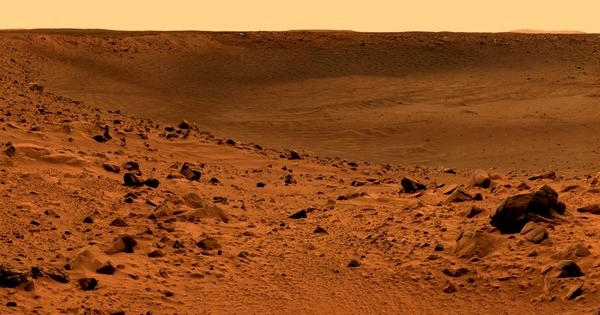Researchers from Monash University, the University of Queensland, and the Australian National University used ANSTO’s Australian Synchrotron to investigate meteorites found on Earth that could be used to find evidence of life on Mars in the future.
A collaborative team led by Dr. Andrew Langendam of the Australian Synchrotron examined meteorites retrieved from the Nullarbor Plain in western South Australia and discovered organic remnants in the form of microfossils trapped in mineral veins inside the thick rock.
Since the 1980s, it has been a well-known location for meteorite hunting. “The dark iron-rich meteorites stand out against the plain’s white limestone and red dirt,” Dr. Langendam stated.
The study also discovered a variety of fossil microorganisms, diatoms, bacteria, and fungi entombed and preserved within calcite and gypsum veins.
“It has been an established site for finding meteorites since the 1980s. The dark iron-rich meteorites stand out against the white limestone and red soil of the plain, ”
Dr. Langendam
Dr. Jessica Hamilton (then a Ph.D. student at Monash) and Dr. David Paterson, both co-authors, confirmed that redox-active metals, such as manganese and iron, were mobilized in vein-filled cracks within the meteorite by environmental or microbial activity using X-ray fluorescence microscopy at the Australian Synchrotron.
“The ultra-sensitive technology can determine the location and amount of calcium, iron, and manganese in a sample. It was discovered that manganese enrichment took place along the periphery of calcite-gypsum veins, “Dr. Hamilton stated.

According to the research team, under the arid circumstances of the Nullarbor, meteorites could preserve a suite of microfossils, organic biosignatures, and traces of nutrient cycling.
Dr. Alastair Tait of Monash University’s School of Earth, Atmosphere, and Environment, a co-lead author on the paper published in Geochemica et Cosmochemica Acta and Frontiers in Microbiology, said in a news report on the Monash website, “This is an original finding and it is important because it shows us that microorganisms can interact with astro-materials in a way that is vital to their metabolism.”
In a news story on the UQ website, co-lead author Prof Gordon Southam of the University of Queensland’s School of Earth and Environmental Sciences said, “This offers a new dimension to the search for life on Mars, targeting analogous meteorites on the red planet.”
“Essentially, they give a time capsule of historical biological activity, or, in the case of Nullarbor Plain samples, meteorites can serve as a haven for life,” Prof. Southam explained.
“They operate as lifeboats for life on a hostile surface with little bioavailable minerals,” Dr. Langendam explained.
In comparison to Earth, Mars has a harsh environment. The temperature of Mars’ desert-like surface is around -62 degrees Celsius. It has an extremely thin atmosphere that is 96% carbon dioxide. Mars’ atmosphere is significantly less dense than Earth’s atmosphere, with extremely low air pressure.
By examining how meteorites on Earth are transformed by weathering and microbial activity, we may be able to determine what chemical signatures to search for when studying meteorites that fell on Mars, which could have been weathered and potentially altered by any life there. Dr. Hamilton stated that looking at meteorite chemistry as an environmental record and a potential means to compare processes on Earth and other worlds is a novel and interesting concept.
Although a number of research vehicles, including the most recent Perseverance Rover, have investigated the Martian topography, no actual samples from the planet’s surface have been returned to Earth as of yet. Instruments on the surface analyze the samples.
The research team proposed that materials returned from Mars be utilized to construct an overall picture of Mars’ volcanic and sedimentary history, in which previous life could be preserved.





